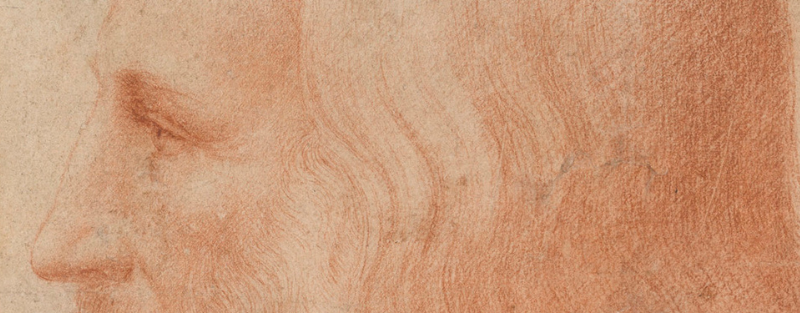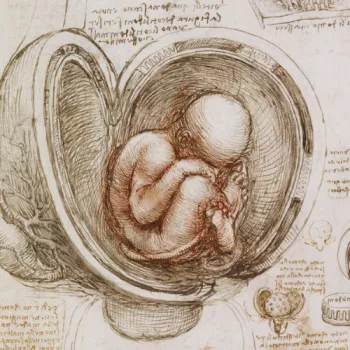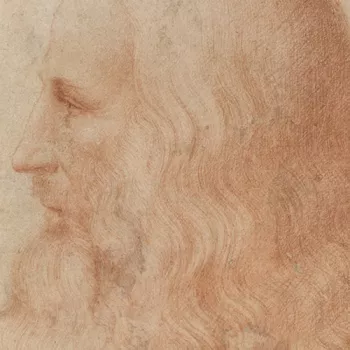
Leonardo in the Royal Collection
A closer look at Leonardo da Vinci's works.
Top 10 Leonardo Drawings in the Royal Collection
There are nearly 600 drawings by Leonardo da Vinci in the Royal Collection. They were originally bound together in a single album and likely acquired by Charles II in the 17th century. They are renowned for their detail, technical skill, and the breadth of ideas they represent. As only around 20 of Leonardo’s paintings survive, the drawings are the main source of our knowledge into the mind of this extraordinary man and his activities. Learn more about some of the highlights in the Collection.
1. The drapery of a kneeling figure
There are two versions of Leonardo’s painting, The Virgin of the Rocks. This is a preparatory study for the kneeling angel in the second version, completed around 1508 and now in the National Gallery, London. Leonardo likely made this study from cloth which had been soaked in diluted plaster and draped over a model. This enabled him to work at his leisure. While Leonardo was meticulous, he was also incredibly slow, leaving many of his works unfinished.
2. Designs for gun-barrels and mortars
Among Leonardo’s drawings are designs for weapons of war, which he began to produce soon after arriving in Milan – Italy’s leading centre for the production of arms and armour. This drawing shows several designs for gun-barrels and mortars used to discharge an incendiary weapon known as ‘Greek fire’.
3. Studies of a horse
In the 1480s, Ludovico Sforza (the Duke of Milan) commissioned Leonardo to create an enormous equestrian monument to his father Francesco. In preparation, Leonardo produced many studies of horses, including this metalpoint drawing. This technique was used to train young artists in Italy due to the high level of skill required. A metal stylus is used to draw onto a surface prepared with finely ground bone. This leaves an opaque metal line that cannot be erased.
4. A man tricked by Gypsies
This is one of Leonardo’s most elaborate drawings. They are known more generally as ‘grotesques’, as they represent figures with exaggerated features. In the centre of the drawing is an elderly man with a wreath around his head. He is surrounded by a band of Gypsies in traditional dress. The man raises his right arm for the old woman to read his palm (the sheet has been cut and the palm reading trimmed off). Meanwhile, the grinning Gypsy on the left steals his purse. This was likely made for the entertainment of the Sforza court, where Leonardo worked in the years around 1490.
5. The head of Leda
Leonardo worked on two different compositions of Leda and the Swan. In one version Leda kneels, and in the other she stands. In Greek mythology, the god Zeus (Jupiter) transformed into a swan to seduce Leda, the queen of Sparta. Leda bore two eggs, and from each hatched twins. These are preparatory studies for Leonardo's lost painting of Leda and the Swan. Here, he devoted little effort to Leda’s downward glance, and instead focused on her elaborate, braided hairstyle.
6. A map of southern Tuscany
Many of Leonardo’s maps were made during his service to Cesare Borgia from 1502-3. This example is a detailed and highly finished map of Southern Tuscany. While the purpose of this sheet is not clear, it was likely made as a survey of the malarial marsh as part of a drainage project. Leonardo has written the labels in the conventional direction, rather than in reverse (‘mirror writing’), which indicates that it was intended for others to read.
7. A star-of-Bethlehem
In this drawing, Leonardo carefully observed the swirling leaves of the star-of-Bethlehem flower. It is one of Leonardo’s most beautiful nature drawings and appears in preparatory studies of the kneeling Leda and in most copies of the painting. Although stylised, the untidy blades of grass behind suggest that Leonardo studied the flower from nature.
8. Studies of water
Leonardo was fascinated by water. He surveyed the Arno for the Florentine government and designed a canal to make Florence accessible by sea. From 1508 to 1511, he also studied hydraulics in great detail with the intention of compiling a treatise. This is one of Leonardo’s most elaborate water studies. In the upper drawing, he examines how water flows past an obstacle, observing stable, repeatable patterns. In the lower drawing, Leonardo shows a stream of water falling into a pool. This produces bubbles that form expanding circles, a phenomenon he studied in his work on wave movement.
9. The muscles of the shoulder and arm
Leonardo’s anatomical drawings are remarkably detailed, reflecting a profound knowledge of the human body gained through careful dissections and observations. This drawing is part of Leonardo’s ‘Anatomical Manuscript A’, a collection of 18 sheets that contain over 240 individual drawings of bones and muscles. This page includes three drawings of a deep dissection of the shoulder muscles, two studies of the muscles in the right shoulder, a diagram of the respiratory muscles, and a skeleton of a left foot.
10. Cats, lions and a dragon
This is one of Leonardo’s most charming sheets, on which he sketched over 20 studies of cats in various poses. Some play, some fight; others prowl, or look frightened and suspicious. The most detailed drawings (at centre right) show the cats sleeping. These cats appear to have been studied directly from life. Surrounding the studies of cats, are seven drawings of a lioness, which Leonardo may have been able to observe from life, caged, while in Florence. In the lower half, there is also a study of a coiling dragon - an imaginative example of the positions and movements possible by members of the cat family.










